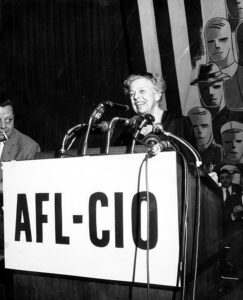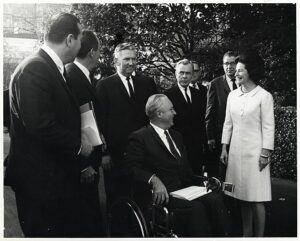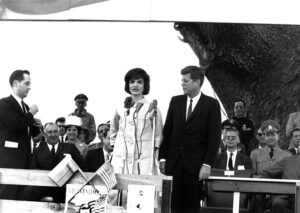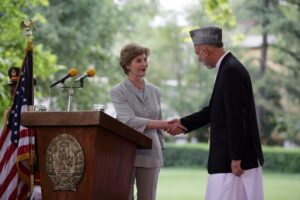Appreciating the American First Lady as a PR Asset
Published on April 29, 2023, at 8:06 a.m.
by Ginger Morrow.
The American first lady has attracted national and international attention since the inception of the country. While her position has evolved from a chief social event organizer to a political figure in her own right, her relationship with the media and the public has evolved, too.
Early media relations
When George Washington assumed office in 1789, the American public was braving new political waters. The predominantly European colonies had only ever been governed under a monarchical system.
According to Lisa Burns, professor of media studies at Quinnipiac University, this history influenced how the media covered Washington and, naturally, his wife, Martha. Early American newspapers grew critical of her lavish entertaining, questioning if the Washingtons intended to become the stateside version of the unpopular British royal family. For this and social reasons, early first ladies avoided the press when possible.

National media began to take shape in the early 20th century, and the first ladies began utilizing it in new ways. Edith Roosevelt, according to Burns, was one of the earliest examples. She and her social secretary distributed press releases that satiated the media’s unending interest in the colorful Roosevelt family and their many pets.
It was the next Roosevelt wife who truly transformed the position of the first lady into a working, involved and public role. Eleanor Roosevelt hosted women’s conferences, wrote a daily newspaper column and appeared in popular newsreels shown in movie theaters during her time in the White House and after.
“She raised the profile of the president’s wife by leaps and bounds,” said Katherine Jellison, a professor at Ohio University and an expert in first lady history.
Franklin Roosevelt used a wheelchair after a bout of polio he suffered 10 years before becoming president. He worried that his disability might affect Americans’ opinion of him as he climbed the political ladder. Eleanor viewed her position as an opportunity to promote her husband’s work while boosting his image. She made frequent public appearances on his behalf, helping to keep his paralysis under wraps.
According to Burns, she also used her newspaper column and press conferences as a way to “test out” ideas for new policies and initiatives that the White House might be interested in tackling.
First ladies after Eleanor Roosevelt were not always as active, but she charted new territory. She created the opportunity for a president’s wife to implement initiatives and spend more time in the public eye — not just as a celebrity distraction but as a true change-maker.
Moving into modernity
Jacqueline Kennedy ushered in a new era of public interest in the first lady. She was the object of intense media following and cemented herself as a fashion icon, an image that has survived to this day.
Many first ladies after Kennedy continued to capitalize on this media interest. Lady Bird Johnson, for example, served as the face for many of her husband’s Great Society programs. She was a trained journalist, so she knew just how to appease the press and get a positive story about the Johnson administration’s work.

“She would make sure that [reporters] heard what she was saying,” Burns said. “If it was a good quote, she would say, ‘Did you get that? Do you need me to repeat that?’ She really understood that she was helping to generate positive coverage of the administration.”
Betty Ford attracted special media attention as a charismatic first lady who put her struggle with breast cancer at the forefront of her time in the White House. “She was instrumental in publicizing that women should do self-exams and get regular mammograms,” Jellison said.
Laura Bush came to be known as “comforter-in-chief” following the attacks of Sept. 11, 2001. “Her husband had a very specific thing that he needed to do as commander-in-chief. She became the ‘how do we deal with this on a family level?’ [person]. And when you bridge those two together, I think that’s why we saw such a positive reaction to how they handled 9/11,” Burns said. In this way, Bush had her own impact on the position.
Michelle Obama modernized the office again as the first president’s wife to use social media to promote her initiatives. She set new standards that continue to provide the first lady with a more direct connection to her public.
Effects on presidential legacy
First ladies can make waves in the media, but how long does their work truly last?
According to Jellison, it is clear that presidents, their actions and the circumstances they face mostly determine their legacies. This is to be expected — after all, they are the commanders-in-chief — but first ladies can certainly still have an impact.
Jellison and Burns agreed that the most successful first ladies have tended to choose personal projects that complement the goals of their husbands’ administrations. These conscious choices demonstrate unity to the press, increase the likelihood of success for both his policies and her initiatives, and secure a cohesive, longtime impact.

“People like to see the first lady be loyal to her husband, maybe even when he doesn’t deserve it,” Jellison said.
Some first ladies have succeeded in improving the image of their husbands while they were occupying the White House. Compelling and charismatic first ladies have been known to soften the president’s image. During wartime, according to Burns, they have often made concerted efforts to keep their work light and cheerful.
Wives of presidents who did not survive their terms have perhaps had the most obvious effect on the public’s perception of their husbands. The most famous example is Jacqueline Kennedy, who characterized the three years of John F. Kennedy’s presidency as a period of idyllic progress she called “Camelot.”
Relevance for the PR practice
Jellison and Burns agreed that the American public admires the first lady similarly as they admire celebrities. The beautiful and unattainable pageantry of this highest political marriage never fails to fascinate onlookers.
But there is far more to the process of branding a memorable first lady that public relations professionals can apply in working for their clients.
First, Jellison and Burns again agreed that authenticity in the right moments can fastly endear a public.
They also agreed that the first lady team must have excellent working relationships with the press, which is certainly true of PR professionals working on the behalf of individuals and organizations.

Burns noted that effective first ladies have employed teams that knew how to play to their strengths — for example, Michelle Obama performed best in scripted situations, and Laura Bush was a strong public speaker with a killer wit. It is the job of the public relations practitioner to set their client up for success, and that takes an understanding of the client that goes above and beyond general information.
Both experts emphasized the importance of clear messaging. Clearly defined goals and definitive messaging are important not only to the first lady, but to all communications professionals.
Burns noted that there is really no pleasing the public completely, but that the first lady’s “soft skills” are indispensable to her husband’s image, humanizing the often all-too-serious leader of the free world.
“These are women who, even if it’s a soft power, their power comes mainly through the media and through public relations. That is where their power lies,” Burns concluded.




